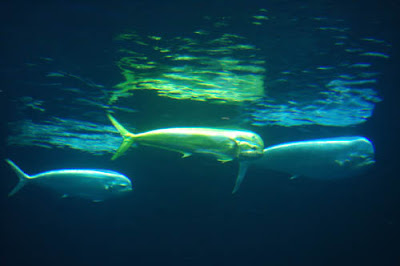Mahi Mahi | Mahi Mahi is also known as dorado or dolphin fish grow rapidly. They are among the finest of all fish. The Mahi Mahi
is a pelagic fish found in off-shore temperate, tropical and
subtropical waters throughout the world. It is one of only two members
of the coryphaenidae family, the other being the Pompano
dolphinfish. This fish is one of the top offshore gamefish among the
fishermen and is an excellent, hard fighting species that puts on an
acrobatic show once sold. Mahi Mahi has slim and streamlined
body, tapered sharply from head to tail. Large male, called bulls, have
high, vertical foreheads, while the female's forehead is rounded. The
anal fin is 25-31 soft radiation and is long, which extends over half
the length of the body. The dorsal fin has 55 to 66 soft rays. The tail
fin is very forked, there are no protrusions in one of the fins and the
mouth has bands of fine teeth.
Scientific classification
Kingdom: Animalia
Phylum: Chordata
Class: Actinopterygii
Order: Perciformes
Family: Coryphaenidae
Genus: Coryphaena
Species: C. hippurus
Kingdom: Animalia
Phylum: Chordata
Class: Actinopterygii
Order: Perciformes
Family: Coryphaenidae
Genus: Coryphaena
Species: C. hippurus
Coloring of Mahi Mahi is variable and defies an accurate, simple description. Generally, when the fish lives in water, the Mahi Mahi
is rich iridescent blue or blue-green dorsally, gold, blue and gold or
silver gold on the lower flanks, and silvery white or yellow on the
belly. The sides are sprinkled with a mixture of dark and light spots,
ranging from black or blue to golden. The dorsal fin is rich blue, and
the anal fin is gold or silver. The other fins are generally golden
yellow, edged with blue. Dark vertical bands sometimes appear when the
fish attacked prey. The color description of the Mahi Mahi is difficult because it undergoes sudden changes in color that occur in an instant, often when the fish is excited.
If
the fish out of water, but colors range from blue, green and yellow,
the colors that were clear when in the water quickly fade. After the
death of the fish is usually a uniform yellow or silver. Mahi Mahi
are among the fastest growing fish. They spawn in the warm ocean
currents in a large part of the year, and their young are often found in
seaweed. Mahi Mahi grow fast and of short duration. Few Mahi Mahi
live longer than 4 years, and most live only 3 years. Males larger than
females and are able to grow to 60 pounds in just 2 years, but this is
exceptional and the result of consistently favorable warm water
temperatures and abundant food.
Mahi Mahi
are extremely fast swimmers and feed in pairs, small packages, and
schools, widely consume some food fish are most abundant. Flying Fish
and squid are prominent food in areas where they exist, and small fish
and crustaceans that are about floating Sargassum weed are usually part
of the diet, especially for smaller dolphin. Mahi Mahi are very aggressive feeders, and they can move very quickly to capture a meal.
The Mahi Mahi
is a prolific spawner and grows rapidly, which means that it must by
nature an eating machine. Spawning begins in the first place in the
spring or early summer and lasts several months in warmer waters. Mahi Mahi sexual maturity in their first year of life and produce a large quantity of eggs. Mahi Mahi
schools and are often gathered in large numbers, sometimes by the
thousands. They are almost always between the surface and 100 m depth,
but they are found by fishermen on or just below the surface and are
probably the most surface-oriented of all big-game fishing. This, plus
the fact that they are visually oriented feeders mainly forage in the
daylight, helps them to loved anglers. Offshore anglers encounter packs
of dolphins and are able to entice strikes from different fish in quick
order.
Mahi Mahi
are highly sought after for sport fishing and commercial purposes.
Sport fishermen try them due to their beauty, size, food quality and
healthy population. Mahi-mahi is popular in many restaurants. Mahi Mahi can
be caught a number of ways. The simplest and most common is the troll
around sea bass pots or lobster pots. Weed lines and floating wood and
other materials, excellent places to look. Mahi Mahi sometimes orient to objects as small as a cup of coffee.
The
United States and the Caribbean countries are the main consumers of
these fish, but many European countries to increase their consumption
per year. Mahi Mahi is a popular food fish in Australia, mostly
caught and sold as a byproduct of commercial tuna and swordfish fishery
operators. Japan and Hawaii are major consumers. The Arabian Sea,
particularly off the coast of Oman, has also Mahi Mahi.
Initially, mahi-mahi were mostly catch (bycatch) in the tuna and
swordfish longline fisheries. Now they are sought by commercial
fishermen on their own merits.








Hello, the English used in this blog is confusing. If you want it written more clearly, contact me at gotoalex2010@live.com
ReplyDeleteAh, to be the Mahi Mahi in that final picture.
ReplyDelete